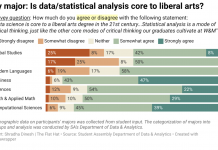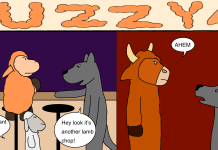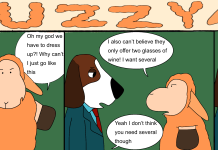Let us bow our heads, now, and have a moment to honor the dearly departed — not the title characters of “Rosencrantz and Guildenstern are Dead,” the Tom Stoppard play running this weekend as part of William and Mary Theatre’s Second Season — rather, let something a little more simple be remembered, something less tangible, yet altogether essential to the understanding of a play which carefully explores difficult subjects in clever and insightful ways.
I am referring to silence itself; that key to bleakness and boredom, that way of making an audience question whether the show is supposed to still be going indeed, if it ever began. The characters in Megan Behm’s ’11 production, although deft and able in their roles as ciphers for Stoppard’s wit and wisdom, don’t clam up as much as they should. Yes, it’s very strange to want more nothing in something, much less a play. But for a work like this, there is often a shortage of nothing, even after it seems the pauses couldn’t be any more pregnant.
Set in the same span of time as Shakespeare’s “Hamlet,” “Rosencrantz and Guildenstern are Dead” follows the two messengers and presumed confidantes to the Danish prince. “Follows” may be the very antithesis of what Ros and Guil do, however, as vast chunks of the play are set in the spaces between their action in the original play. For those not brushed up on their “Hamlet,” these guys aren’t on much; they pass the time playing games of chance and discussing philosophical ideas. Guildenstern appears at first to be the more rational, Rosencrantz the more lackadaisical. The games, however, don’t involve much chance, and the implications of their debates on present circumstances are soundly ignored. This is, above all, a play about humanity’s transitory existence; seeing the forest for the trees would mean these characters understand their plight, and that isn’t as interesting to watch.
The dead men are aptly cast and performed: C.J. Bergin ’11(Rosencrantz) is a lovable buffoon who lapses into moments of epiphany as his character and Guildenstern’s become increasingly interchangeable. Macs Smith ’11 as Bergin’s counterpart maintains a cold, logical distance from the proceedings, until he is pushed to the brink in a spectacular fashion. His transformation is as powerful as it is tragic. Although they hold the play’s significance on their shoulders, these actors rarely fail to amuse, as can be seen in the elastic face and wide eyes of Bergin and the frantic attempts by Smith to hold everything together.
Joel White ’13, as the leader of a group of amoral theatrics, is less boisterous than a more traditional reading of his character would provide. His Player is all smirks and devilry, treating death as little more than an elaborate trick of the stage; through him the metatheatre of “Rosencrantz and Guildenstern” takes its purest form. The Tragedians, underlings and performers to White’s slick personage, also double as the “Hamlet” characters, a decision from Behm that further calls into question the nature of reality for this production: The critical viewer from time to time remembers that everyone in a play is an actor. Here, that notion is externalized, and everyone is, quite literally, playing a part. So, what is real? Are these real men, whose deaths should move us? Or are they pawns in our occasional exercises into escapism? Only Nathan Sivak ’13, as an equally deranged and fiery Hamlet, keeps his place firmly in the goings-on of Shakespeare’s play. Perhaps the Dane is the one sane man in this world of ambiguity, or perhaps he’s the only one not in on the joke.
The technical elements are simple: Minimalism is the word of the day, and the largely bare and black stage provides good canvas for the ethical and philosophical tennis matches that routinely take place. Costumes are just as bare-bones, with only Hamlet and the Player robed in anything remotely extravagant, a selection that owes just as much to their separation from the rest of the characters as it does the characters themselves. Lighting is subtle but effective — thankfully, one is spared the typical harsh red glow associated with onstage murder.
Stoppard’s themes are explored effectively enough in Behm’s production; to be honest, there really isn’t anything significant missing. Yet, as important as Stoppard’s words are for the success of his play, there is value to be had in the tantalizing moments of insecurity, the paralyzing occasions of emptiness. Rosencrantz and Guildenstern are stuck in a hopeless existential prison, and that is their tragedy. Stoppard wants to share this feeling, to liberate his audience.


































